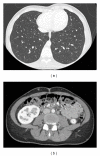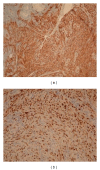Visceral Kaposi's Sarcoma Related to Human Herpesvirus-8 in Liver Transplant Recipient: Case Report and Literature Review
- PMID: 23320218
- PMCID: PMC3539345
- DOI: 10.1155/2012/137291
Visceral Kaposi's Sarcoma Related to Human Herpesvirus-8 in Liver Transplant Recipient: Case Report and Literature Review
Abstract
Background. Kaposi's sarcoma (KS) in transplant recipients is about 400 to 500 times rate in the general population. It is strongly associated to Human herpesvirus-8 (HHV-8) infection which has been found in 95% of KS lesions. The optimal approach to managing posttransplantation KS is to reduce or discontinue immunosuppressive therapy but this strategy carries a risk of the acute rejection of the graft. Recently, the use of an mTOR inhibitor has added new opportunities for KS treatment and prevention. Case Report. We report a case of 24 years-old Turkish woman with visceral HHV-8-associated Kaposi's sarcoma after orthotopic liver transplantation. Conclusion. Posttransplantation KS is considered an experimental model of virus induced tumor suggesting the usefulness of HHV-8 screening in transplant recipient and donor. Therapeutic approaches are complex and require a multidisciplinary team.
Figures



References
-
- Penn I. Sarcomas in organ allograft recipients. Transplantation. 1995;60(12):1485–1491. - PubMed
-
- Farge D. Kaposi’s sarcoma in organ transplant recipients. European Journal of Medicine. 1993;2(6):339–343. - PubMed
-
- Baccarani U, Piselli P, Serraino D, et al. Comparison of de novo tumours after liver transplantation with incidence rates from Italian cancer registries. Digestive and Liver Disease. 2010;42(1):55–60. - PubMed
-
- Moosa MR. Kaposi’s sarcoma in kidney transplant recipients: a 23-year experience. Quarterly Journal of Mathematics. 2005;98(3):205–214. - PubMed
-
- Aseni P, Vertemati M, Minola E, et al. Kaposi’s sarcoma in liver transplant recipients: morphological and clinical description. Liver Transplantation. 2001;7(9):816–823. - PubMed
LinkOut - more resources
Full Text Sources
Miscellaneous

